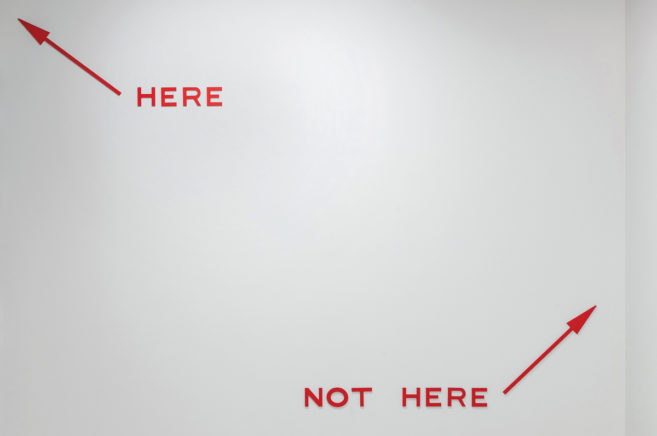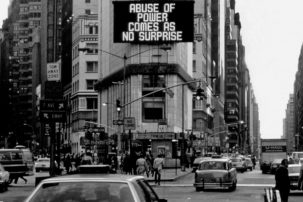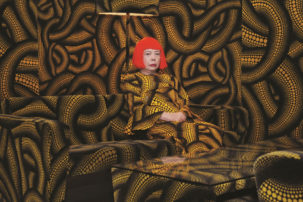“The gallery is currently closed for installation.” Behind these doors, which get rattled despite the taped-up notice, is a team of people making sure that, on opening, things look just as they should. They’re known as art handlers, preparators, preps, installers, installation technicians, techs. Sometimes, I am one of them.
Such titles might conjure fitted cotton gloves, resonant white rooms and gently swaying ponytails, but contemporary artworks that are immaterial, digital or built on-site as exhibition copies only to be destroyed are just as common as works that arrive as complete, discrete things. Art handling is but one aspect of exhibition-making, and so many institutions, in true neoliberal fashion, do not keep it separate from the dirty work of spatial reconstruction. Most techs are contract workers with no benefits, stability or security. Their competencies include art handling, condition reporting, assembling, hanging, crating, demolition, building, wall framing, drywalling, mudding, sanding, painting, lighting, electrical, installing and troubleshooting various analog and digital audiovisual formats, plus a smattering of unclassifiable tasks. Training opportunities specifically to become a tech are few, so generally, these abilities are gleaned through previous jobs or educations that incidentally teach applicable skills. Interested workers tend to be practicing artists with BFAs and MFAs, self-identified artists who abandoned their studios years ago or skilled tradespeople.
The techs I spoke with said they were drawn to this work after art school: it would keep them close to art and artists, building on their own skill sets while supporting their peers. New hires are quickly initiated in the highly coded nuances and etiquette of art handling. As Montreal artist and tech Kandis Friesen writes in a 2016 issue of MICE Magazine devoted to “Invisible Labour,” workflow “requires flexibility and an understanding of how the artwork is made, installed, displayed, accessed, maintained, transported, and stored. The gestures involved in this labour often alternate between intuitive and highly choreographed movements, with one’s body learning how to hold, carry, and install the work’s components as needed.”
Less often considered is the mental component of the body enacting these procedures. The tech, whom we can assume to be invested in some significant manner in the idea or importance of art, knowingly participates in a belief system: every art object deserves to be treated with the same respect, regardless of its materials, provenance, maker or aims. Their performance of care corroborates this belief; they appear tacitly, straightforwardly supportive.
But while I may neutralize for the job, I am not essentially neutral. When I’m not on contract as a tech, I’m writing, and the artists I work with are also, like all good artists, critics. “My work as a technician has…led me to think deeply about the assertion of value, status, and worth,” Friesen writes. The process can be intimate, frustrating, exciting, cumbersome, humbling and sometimes funny. As Calgary-based artist and tech Magnus Tiesenhausen explains, “I’m constantly laughing internally, which is partially why I love my job. It’s almost psychedelic to engage with something in this extremely strict manner and at the same time think, What the fuck am I doing?” There is a criticality unique to the tech: the artwork as seen through the lens of the specific labour required to accommodate it.
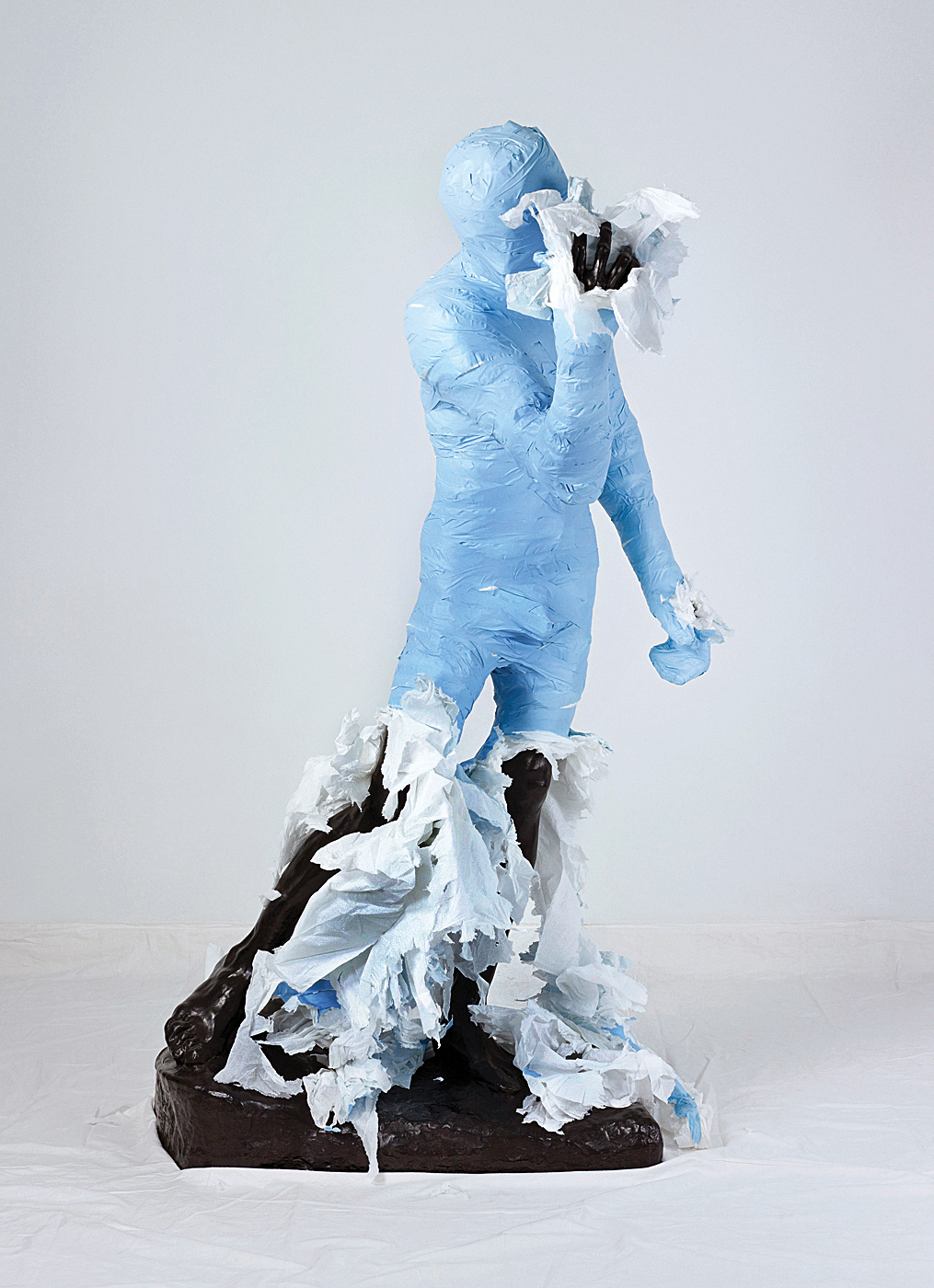 Adad Hannah, Unwrapping Rodin (Blue) 4, 2010. Colour photograph, 1.75 x 1.27 m. Courtesy Pierre-François art contemporain/Equinox Gallery.
Adad Hannah, Unwrapping Rodin (Blue) 4, 2010. Colour photograph, 1.75 x 1.27 m. Courtesy Pierre-François art contemporain/Equinox Gallery.
Considering that techs step in to complete the thing most central to an art institution’s function, their experiences can be fragmentary. While techs may come to feel at home at galleries they work at every couple of months, their relationships with gallery staff can be strained, or hard to establish. As Toronto writer Barbora Raceviciute puts it, relationships require patience, patience requires energy and, in the context of culture work, energy is in short supply. As someone who has filled administrative and programming roles in addition to my tech and writing work, I’ve witnessed this unfortunate divide from both sides.
In one of my experiences as a tech, I was part of a team that voiced concerns about key tenets of an exhibition during installation. The curator responsible for the project never addressed the crew, but a different curator fielded the concerns, saying condescendingly that they were happy to find out that the techs were thinking critically about the exhibition. After it opened, the exhibition went on to be publicly criticized for the same points the techs had raised. But I’ve also seen curators ask techs to weigh in on key choices that become manifest in the exhibition. The tech is sometimes treated as a service worker, and other times, as an expert. There is an invisibility to both roles. They are expected to support and advise on the vision and decisions toward the presentation of a work, be it manually, cerebrally, emotionally or creatively.
Gallery staff often aren’t versed in the language of the tech, and techs are generally not privy to the many conceptual and logistical aspects of exhibition-making that occur before they enter the building. Techs begin their contracts after significant decisions have been made. If things go wrong, it tends to be because much is revealed about a work and its presentation needs once it arrives. For a curator, who by that point has been imagining a certain thing in a certain way for months, this is obviously frustrating, and all the more so if technical details attempting to clarify the issue are hard to parse. Part of the tech’s job is to ensure that a common language can be established in these situations. Issues with language can run the other way too. A curator might try to explain a technical need outside conceptual language—moving into what they assume is the tech’s vernacular—but this can sometimes be more complicated for techs, who are often also conversant in theory and artspeak. Unfortunately, tight timelines and high stress mean productive cross-pollination is limited.
“There is just no foundation upon which collaborative work can happen between the salaried and non-salaried on a regular basis,” says one tech I spoke with. “So much collaborative decision-making happens around the presentation of a work during installation, including how ideas can be best matched to resources. But it’s hard work, because no language, process or workflow really translates from exhibition to exhibition entirely, and no base process that could has ever been put into practice.”
 Adad Hannah, Unwrapping Rodin (Blue) 6, 2010. Colour photograph, 1.75 x 1.27 m. Courtesy Pierre-François art contemporain/Equinox Gallery.
Adad Hannah, Unwrapping Rodin (Blue) 6, 2010. Colour photograph, 1.75 x 1.27 m. Courtesy Pierre-François art contemporain/Equinox Gallery.
Skilled manual labourers have long been professionally, economically and socially stigmatized, and the tech is not exempt. Contemporary art discourse is ubiquitously intellectual; techs’ labour is viewed as being of the body (and therefore, as if mutually exclusive, not of the mind). The particular saltiness of this in the art world is that it is an industry that gives primacy to ideas of exchange and analysis. It puffs out its chest about progressive politics, materialist and institutional critique, and social justice. Antioppression sentiments that are paid lip service via mandates, job postings and, yes, programming and exhibitions are often not reflected in internal operations and work culture.
I’ve witnessed instances where upper-level gallery staff suddenly realize that a certain tech is in fact a certain artist represented by a certain gallerist. The treatment of that person improves. This illustrates a disturbing conundrum for artists who actively pursue studio practices but may be better known as techs. One artist and tech I spoke with said even her artistic peers tend to be more likely to ask about her day job as a tech than about what she’s currently working on in the studio. In her words: “Talk to me about the thing that I care about, not the thing that I do to be able to do the thing that I care about.”
Some galleries publicly credit their techs by name, in what is ostensibly a well-meaning effort to give credit where it’s due. But this act is contentious for some, who recognize it as yet another example of the institution wearing the mask of ethical conduct. As Toronto artist, organizer and tech Parker Kay says, “It is nice to feel like the work is appreciated, but that happens on more of a person-to-person level.” Some prefer not to be cited in conjunction with exhibitions they work on. The discretion is not about hiding or shame; it’s just that they’d rather be called for a studio visit than to fix a projector.
Inequity in culture work, whatever the variety, can be difficult to address, precisely because entities such as the art world purport to operate in a collective vein that often devolves into cliquishness. As Vika Kirchenbauer writes in her 2017 essay “Aesthetics of Exploitation,” “Within the professional art system, those who publicly denounce…questionable labour practices or directly criticise systematic workings find themselves at career dead ends, considered untrustworthy traitors too risky to work with. This obscures conversations on labour and exploitation within art systems as they rarely extend beyond bar talk within smaller friend circles. How could these shared experiences of exploitation be communicated?… How could systems of accountability be established that would be constructive and address these problems in structural ways without ending up in bitchy art-world gossip, mobbing or scapegoating of individuals?”
 Adad Hannah, Unwrapping Rodin (Blue) 8, 2010. Colour photograph, 1.75 x 1.27 m. Courtesy Pierre-François art contemporain/Equinox Gallery.
Adad Hannah, Unwrapping Rodin (Blue) 8, 2010. Colour photograph, 1.75 x 1.27 m. Courtesy Pierre-François art contemporain/Equinox Gallery.
Stephan Jost, CEO of the Art Gallery of Ontario, remarked on a panel for culture workers in November 2017 that “what you spend your money on tells you what you believe in.” It’s well known that artists and culture workers are underemployed and largely live in low-wage poverty, a condition as egregious as ever for the young. A 2014 study authored by Hill Strategies reported that “artists with university credentials at or above the bachelor’s level earn…55% less than the average earnings of workers in the overall labour force with the same education.”
The pay rate for techs at institutions in Canada tends to range between $17 and $30 per hour, with many hovering in the low $20s. CARFAC, which aims to promote “a socio-economic climate that is conducive to the production of visual arts in Canada,” defines installation as including “unpacking or packing of works, placing works in an exhibition space, ordering, hanging, adjustment of equipment, and so on.” Their 2017 rate calculation for one day of installation work, “over four hours,” is $444, or $55.50 per hour for an eight-hour day. But since CARFAC’s calculations are established for artists, the imagined recipient of this rate is, naturally, the exhibiting artist—not the tech. While it’s essential for exhibiting artists to be present during install, it’s impossible to ignore the effects that power and social capital have in deeming certain people more financially worthy than others to perform what is defined as the same labour. One tech I spoke with said the galleries he works at provide “royal treatment for artists but don’t seem to have any ethical motivation to see that their workers are properly compensated.”
Scarcity of means and resources is a real concern for every non-profit. This is commonly deployed as an excuse to justify situations that are ethically suspect. But what about the $100 bottle of Moët that the intern is asked to fetch as a gift? Or the expensive post-opening dinners? Or lavish fundraising galas, where artists are asked to donate artworks in exchange for a ticket to a dinner that is nearly equivalent to their monthly studio rent? There are so many expenses that non-profit institutions are willing to shoulder in order to affirm the luxury-market dictates of the art world. This posturing comes at a cost for the people who enable the institution to exist at all, techs as well as others.
I always return to visit exhibitions I worked on, a couple of weeks after they open. I’m politely acknowledged by the gallery attendant like the stranger I now am in the space. There’s something clandestine about this: a secret between me, the building and everything temporarily housed in it. Walking through, I see double; I am simultaneously the viewer and one of the people who prepared what I view. Every exhibition has a backdrop—traces of movement, thought, affect, effort, energy—which is never not in dialogue with the exhibition itself. In the contemporary art gallery, we are told again and again to question what we see. But what about all the things we don’t?
Jaclyn Bruneau is a Toronto-based writer, editor, organizer and installation technician. This post is adapted from the article “Labour” in Canadian Art’s Spring 2018 issue, which is themed on “Dirty Words.”

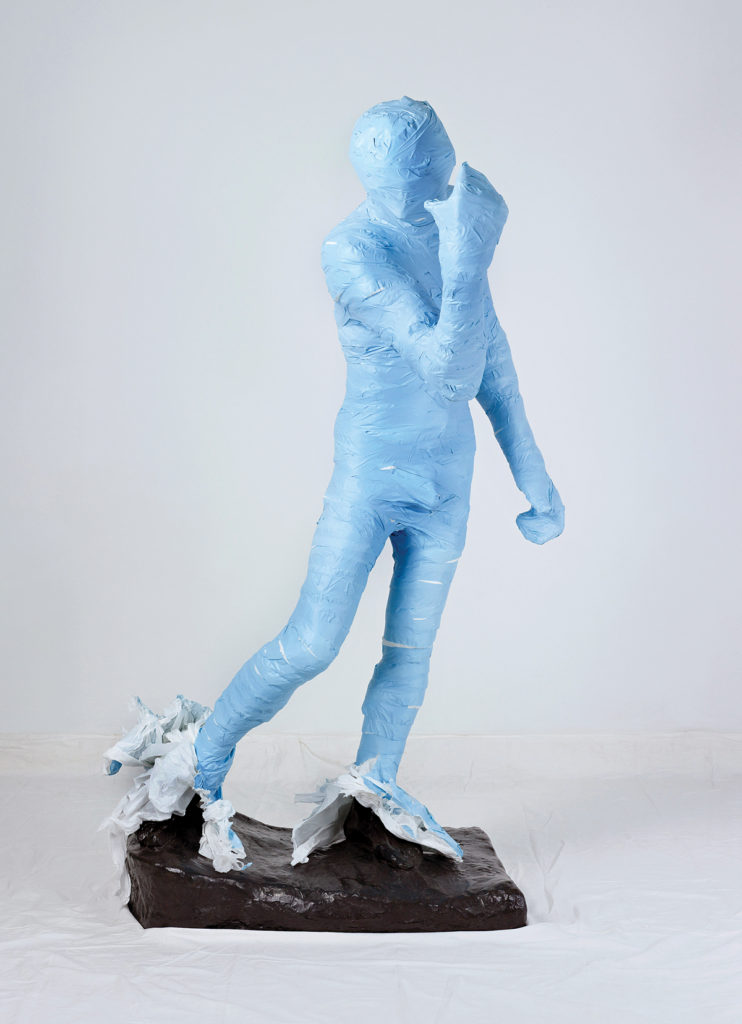 Adad Hannah, Unwrapping Rodin (Blue) 2, 2010. Colour photograph, 1.75 x 1.27 m. Courtesy Pierre-François art contemporain/Equinox Gallery.
Adad Hannah, Unwrapping Rodin (Blue) 2, 2010. Colour photograph, 1.75 x 1.27 m. Courtesy Pierre-François art contemporain/Equinox Gallery.
